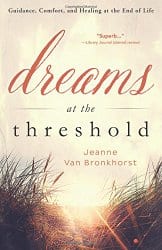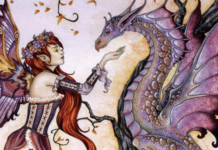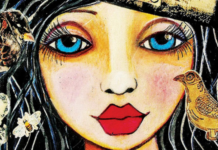
 Dreams at the Threshold: Guidance, Comfort and Healing at the End of Life, by Jeanne Van Bronkhorst
Dreams at the Threshold: Guidance, Comfort and Healing at the End of Life, by Jeanne Van Bronkhorst
Llewellyn Wordwide, 978-0-7387-4234-2, 260 pp., 2015
At the beginning of Dreams at the Threshold, hospice social worker and bereavement counsellor Jeanne Van Bronkhorst tells us her journey into the world of healing dreams began with one simple question to a troubled client: “How are your dreams these days?”
Prior to that, Van Bronkhorst had noticed that dying patients in her care and their families had difficulty speaking of their emotions and opening up about their thoughts and feelings on the impending death, and she wondered how to cross into those tender areas. When she began asking them about their dreams, she found that “dreams opened us easily into conversations about their most pressing concerns… Some talked about their unique relationship with dreaming; some explained their philosophy of life…about how they understood their experience of illness and health. No matter what the answer, the question moved us into a conversation about what mattered most to them in the moment, which made it easier to know what help they needed.”1
Van Bronkhorst began an exploration into the types of dreams present at the end of life, and the types of dreams families and friends had about their dying loved ones. The first part of her book describes these dreams: dreams that support waking life, open important conversations, prepare one for death, grief dreams that help loved ones mourn, or nightmares that frighten the dreamer. The chapters on visitation dreams and what she calls “an expanding universe” — those events that happen at death that seem to have no explanation, or don’t fit into our concept of ordinary reality — are especially fascinating.
What struck me most about Dreams at the Threshold is that throughout it Van Bronkhorst maintains a comforting and open-minded tone, allowing for her readers’ differing viewpoints on the death process and what lies beyond. You get the feeling that she herself believes there is something more, another world waiting for us, but she never imposes her beliefs on us. Nowhere is this simultaneous allowance and belief more evident than in her final two chapters.
Van Bronkhorst reminds us that dreams and their interpretations are highly personal; when someone close to their hour of death dreams of a long-dead relative, that person may simply be comforted by a loving presence, or they may take it as proof consciousness exists beyond death. Either way, “these dreams are a rare grace note at the end of a long, arduous journey, a moment that can utterly transform a person’s death from one of fear and apprehension to one that includes an unexpected joy, peace, wonder, mystery, and grace.”2
Part Two: How to Build a Dreaming Life provides a chapter with instructions on how to listen to a loved one’s end-of-life dreams and another on how to cultivate one’s own dreams. In the former, Van Bronkhorst explains the roots of dream interpretation, as described by psychologists Sigmund Freud and Carl Jung, yet this is just for background information. Here again, she insists that all we need do is assure the dreamer they can speak the dream without judgement, then ask the dreamer what the dream means to them. It’s perfectly fine if the answer is simple, based on everyday life and not deep psychological issues, she says.
In the last chapter, we read about a three-step process to encourage dreaming and to remember our dreams: invite dreams in, listen carefully, and respond with respect. Van Bronkhorst describes practical, simple ways to do each of these, and adds that the last ingredient is trust — in ourselves and in our dreams.
All dream interpretation comes down to a question of trust. Not just whether we trust the dream can be beneficial, but whether we trust ourselves to make good sense of what we dream. In modern Western culture we have been taught not only to distrust dreams because they are nonsense, but also to distrust our own ability to make sense of our dreams.3
Dreams at the Threshold goes a long way toward building this trust in ourselves as dreaming beings who recognize that dreams contain important, and often crucial, messages at the end of life, and indeed, throughout our lives. This book serves as a portal into a little mentioned, but vital, aspect of ourselves that we’d best welcome and pay attention to, especially as death approaches.








